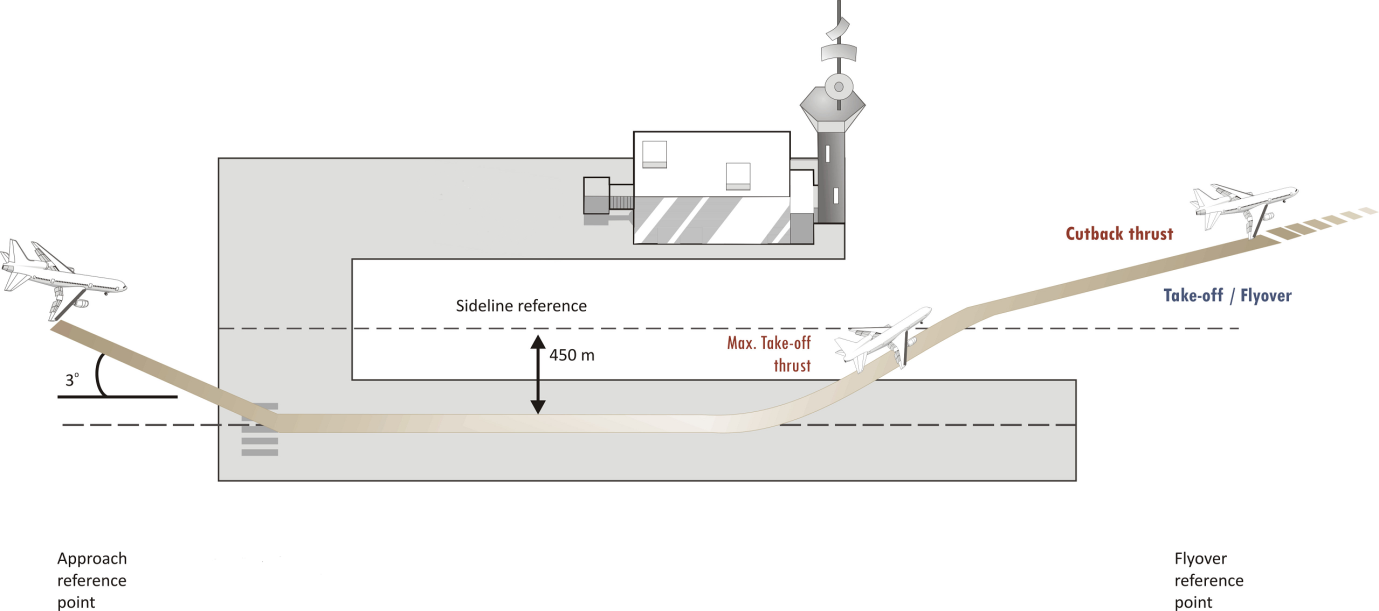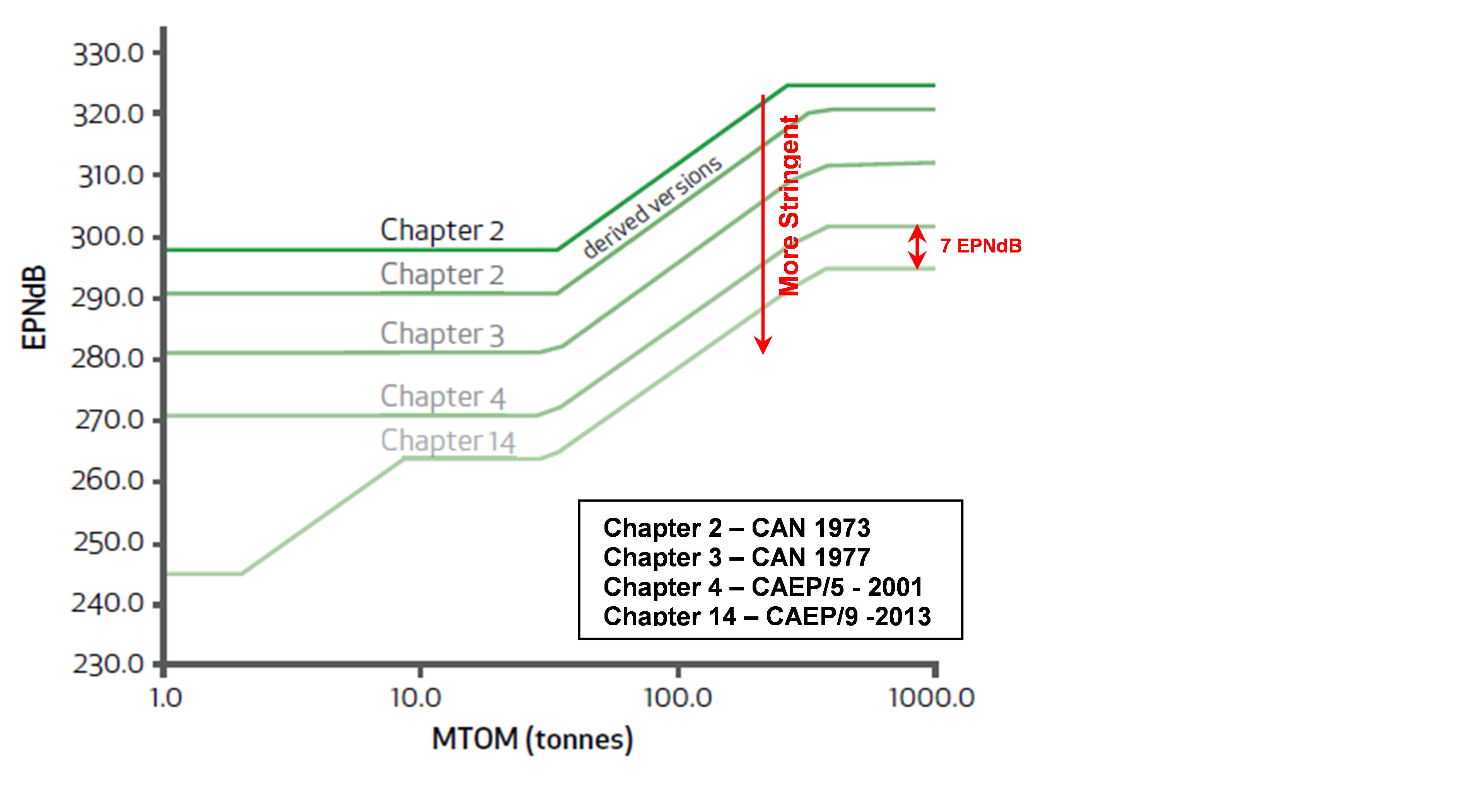Reduction of Noise at Source
An important pillar of the Balanced Approach to Aircraft Noise Management is the reduction of noise at source.
Aircraft noise ("noise at source") has been controlled since the 1970s by the setting of noise limits for aircraft in the form Standards and Recommended Practices (SARPs). This continues to be the case today.
Noise provisions appear in Annex 16, Volume I to the Convention on International Civil Aviation (the "Chicago Convention"). The primary purpose of noise certification is to ensure that the latest available noise reduction technology is incorporated into aircraft design and that this is demonstrated by procedures that are relevant to day-to-day operations. This aims to ensure that noise reductions offered by technology are reflected in reductions around airports.
Annex 16 Vol I is freely available for consultation in the ICAO library, in the six ICAO languages.
 |  |  |  |  |  |
| English | French | Spanish | Russian | Arabic | Chinese |
Noise Standards for jet and large propeller aeroplanes (Chapters 2, 3, 4 and 14 of Annex 16 Vol I)
Based on the recommendations of the "Special Meeting on Aircraft Noise in the Vicinity of Aerodromes" (1969), draft International Standards and Recommended Practices for Aircraft Noise were developed and became applicable in 1972. These Standards define three reference measurement points for noise certification, which are illustrated in Figure 1. The Standards also set noise limits as a direct function of Maximum Take-off Mass (MTOM) in order to recognize that heavier aeroplanes, which were of greater transport capability, produce more noise than lighter aeroplane types. This is the Chapter 2 Noise Standard contained in Annex 16, Volume I. More details on this legacy ICAO Work are provided in the ICAO Environmental Report 2019 (Chapter 2 - 50 years of Annex 16 – the Special Meeting on Aircraft Noise in the Vicinity of Airports) and in the ICAO Environmental Report 2022 (Chapter 2 – Aircraft Noise).

Figure 1: Aircraft noise
certification reference measurement points
Following the introduction of Chapter 2, much higher bypass ratio jet engines were introduced into service. Not only did this new technology deliver improved fuel efficiency, it also resulted in reductions in engine noise. This allowed for the ICAO noise standard to be made more stringent in 1977. This is the Chapter 3 Noise Standard contained in Annex 16, Volume I. In the following years, further noise reduction technologies were incorporated into engine and airframe designs which led to incremental improvements in aircraft noise performance and this resulted in further stringency increase of the noise standard which is contained in Annex 16, Volume I, Chapter 4.
In February 2013 the CAEP/9 meeting recommended an amendment to Annex 16, Volume I involving an increase in stringency of 7 EPNdB (cumulative) relative to the current Chapter 4 levels. In 2014, this recommendation was adopted by the ICAO Council as the new Annex 16, Vol I, Chapter 14 noise standard for jet and propeller-driven aeroplanes. This new, more stringent standard is shown in Figure 2, (along with the previous ICAO noise standards for reference) and this will be the mainstay ICAO Standard for subsonic jet and propeller-driven aeroplane noise for the coming years. It is applicable to new aeroplane types submitted for certification on or after 31 December 2017, and on or after 31 December 2020 for aircraft less than 55 tonnes in mass.

Figure 2. The progression of the ICAO Noise Standards for aeroplanes
As a result of the new Chapter 14 noise Standard, it is expected that the number of people affected by significant aircraft noise will be reduced, and that more than one million people could be removed from "Day Night average sound Level (DNL) of 55 dB affected areas" between 2020 and 2036.
ICAO has also developed practical guidance for certificating authorities on the implementation of the technical procedures of Annex 16, which are contained in the Environmental Technical Manual on the use of Procedures in the Noise Certification of Aircraft (Doc 9501, Volume I).
A Noise database NoisedB is kept by the French DGCA under the aegis of the International Civil Aviation Organization (ICAO). The database is intended to be a general source of information to the public on certification noise levels for each aeroplane type as provided by certification authorities.
Noise Standards for light propeller aeroplanes (Chapters 6 and 10 of Annex 16 Vol I)
Noise Standards for light propeller aeroplanes were first included in Annex 16 in 1974. Currently, these Standards are contained in Annex 16 Vol I Chapter 10, which are restricted to propeller-driven aeroplanes not exceeding 8,618 kg maximum certificated take-off mass.
This Standard is based on a single take-off reference noise measurement point, which is located at a distance of 2 500 m from the start of take-off roll. As is the case for larger aeroplanes, the Standards also set noise limits as a direct function of Maximum Take-off Mass (MTOM).
Noise Standards for helicopters and tiltrotors (Chapters 8, 11 and 13 of Annex 16 Vol I)
Noise Standards for helicopters were first included in Annex 16 in 1981. Currently, the Standards applicable to helicopters are contained in the Chapters 8 and 11 from Annex 16 Vol I. Chapter 8 is applicable to all helicopter types; whereas Chapter 11 provides an optional simplified certification procedure for light helicopters with a maximum certificated take-off mass of 3 175 kg or less.
More recently, in 2014 the ICAO Council adopted noise Standards for tiltrotors, which were included in Chapter 13 of Annex 16 Vol I.
Noise Standards for Supersonics
Currently, Annex 16 Vol I only includes noise standards for supersonic aeroplanes for which the application for Type Certificate was submitted before 1 January 1975. These are provided in Chapter 12 of Annex 16 Vol I. Work is ongoing in ICAO to develop new noise standards for supersonics, as described in more detail here.